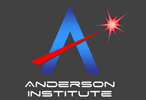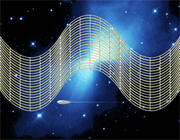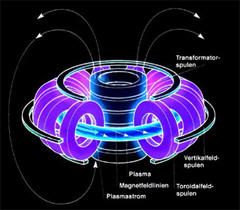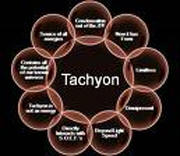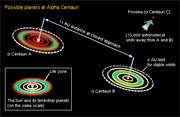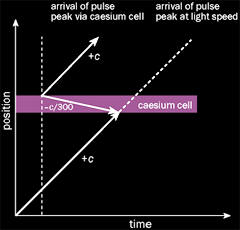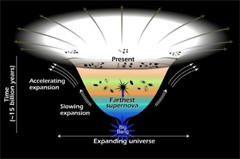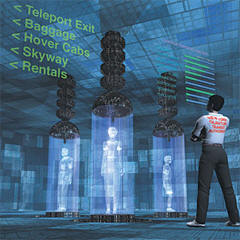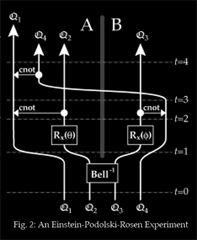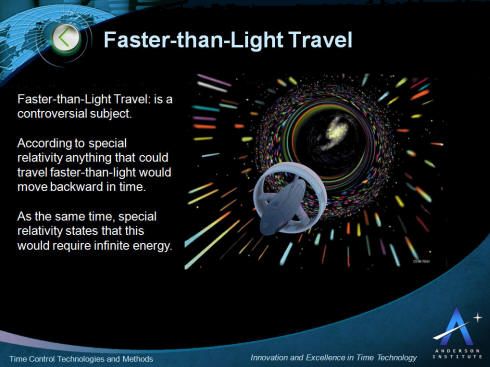
Faster-than-light (also superluminal or FTL) communications and
travel refer to the propagation of information or matter faster
than the speed of light. Under the special theory of relativity,
a particle (that has mass) with subluminal velocity needs
infinite energy to accelerate to the speed of light, although
special relativity does not forbid the existence of particles
that travel faster than light at all times.
On the other hand, what some physicists refer to as "apparent"
or "effective" FTL is the hypothesis that unusually distorted
regions of spacetime might permit matter to reach distant
locations faster than what it would take light in the "normal"
route (though still moving subluminally through the distorted
region).
Apparent FTL is not excluded by general relativity. Examples of
apparent FTL proposals are the Alcubierre drive and the
traversable wormhole, although the physical plausibility of
these solutions is uncertain.
The key characteristics of the application of faster-than-light
travel for time control and time travel are presented in the
picture below. This is followed by more detail describing
the effect below.
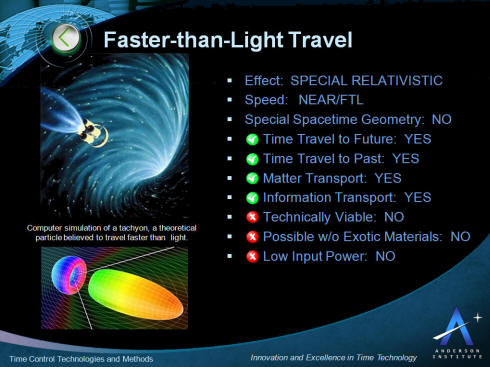
Outside of mainstream physics, others have speculated on
mechanisms that might allow FTL travel to be achieved, often
relying on new conjectures of physics of their own invention,
but their ideas have not gained significant acceptance in the
physics research community. Fictional depictions of superluminal
travel and the mechanisms of achieving it are also a staple of
the science fiction genre.
Travel
In the context of this article, FTL is transmitting
information or matter faster than c, a constant equal to the
speed of light in a vacuum, 299,792,458 meters per second, or
about 186,282 miles per second. This is not quite the same as
traveling faster than light, since:
- Some processes propagate faster than c, but cannot carry
information.
- Light travels at speed c/n when not in a vacuum but
traveling through a medium with refractive index = n (causing
refraction), and in some materials other particles can travel
faster than c/n (but still slower than c), leading to Cherenkov
radiation.
Neither of these phenomena violates special relativity or
creates problems with causality, and thus neither qualifies as
FTL as described here.
Possibility
Faster-than-light communication is, by Einstein's theory of
relativity, equivalent to time travel. According to Einstein's
theory of special relativity, what we measure as the speed of
light in a vacuum is actually the fundamental physical constant
c. This means that all observers, regardless of their relative
velocity, will always measure zero-mass particles such as
photons traveling at c in a vacuum. This result means that
measurements of time and velocity in different frames are no
longer related simply by constant shifts, but are instead
related by Poincaré transformations. These transformations have
important implications:
- The relativistic momentum of a massive particle would increase
with speed in such a way that at the speed of light an object
would have infinite momentum.
- To accelerate an object of non-zero rest mass to c would
require infinite time with any finite acceleration, or infinite
acceleration for a finite amount of time.
- Either way, such acceleration requires infinite energy.
Going beyond the speed of light in a homogeneous space would
hence require more than infinite energy, which is not generally
considered to be a sensible notion.
- Some observers with sub-light relative motion will disagree
about which occurs first of any two events that are separated by
a space-like interval. In other words, any travel that is
faster-than-light will be seen as traveling backwards in time in
some other, equally valid, frames of reference, or need to
assume the speculative hypothesis of possible Lorentz violations
at a presently unobserved scale (for instance the Planck scale).
Therefore any theory which permits "true" FTL also has to cope
with time travel and all its associated paradoxes, or else to
assume the Lorentz invariance to be a symmetry of
thermodynamical statistical nature (hence a symmetry broken at
some presently unobserved scale).
- While Special and general relativity do not allow
superluminal speeds locally, non-local means may be possible,
which means moving with space rather than moving through space.
Justifications
Despite the established conclusion that relativity precludes FTL
travel, some have proposed ways to justify FTL behavior:
Radically Curve Spacetime Using Slip String Drive
There is one way that doesn't violate Relativity. Andrew L.
Bender's Slip String Drive. Bender proposes traveling by
completely isolating a region of spacetime from the rest of our
universe using Einstein's gravity waves. These compression waves
of spacetime are generated by a ship, which emits them from its
hull in all directions until it is completely isolated from the
rest of our universe. Then, by emitting more gravity waves
behind the ship, it stretches out its isolated bubble into an
egg-shape, causing external spacetime to squeeze in on the
bubble unevenly, propelling the craft forward at speeds no
longer limited by relativity. Time passes normally within the
isolated region, eliminating the possibility of paradox or time
travel.
Ignore special relativity
This option is popular particularly in science fiction. However,
empirical and theoretical evidence strongly supports Einstein's
theory of special relativity as the correct description of
high-speed motion, which generalizes the more familiar Galilean
relativity, which is actually an approximation at conventional
(much less than c) speeds. Similarly, general relativity is an
overwhelmingly supported and experimentally verified theory of
gravitation, except in the regime of very high energy densities
over very short distances, where an as-yet-undeveloped theory of
quantum gravity is necessary. Special relativity, however, is
incorporated easily into quantum field theories. Therefore, even
in the broader contexts of general relativity and quantum
mechanics, conventional acceleration from subluminal to
superluminal speeds is not possible.
Faster light (Casimir vacuum and quantum tunneling)
Einstein's equations of special relativity postulate that the
speed of light in a vacuum is invariant in inertial frames. That
is, it will be the same from any frame of reference moving at a
constant speed. The equations do not specify any particular
value for the speed of the light, which is an experimentally
determined quantity for a fixed unit of length. Since 1983, the
unit of length (the meter) has been defined using the speed of
light.
The experimental determination has been made in vacuum. However,
the vacuum we know is not the only possible vacuum which can
exist. The vacuum has energy associated with it, called the
vacuum energy. This vacuum energy can perhaps be changed in
certain cases. When vacuum energy is lowered, light itself has
been predicted to go faster than the standard value 'c'. This is
known as the Scharnhorst effect. Such a vacuum can be produced
by bringing two perfectly smooth metal plates together at near
atomic diameter spacing. It is called a Casimir vacuum.
Calculations imply that light will go faster in such a vacuum by
a minuscule amount: a photon traveling between two plates that
are 1 micrometer apart would increase the photon's speed by only
about one part in 1036. Accordingly there has as yet been no
experimental verification of the prediction. A recent analysis
argued that the Scharnhorst effect cannot be used to send
information backwards in time with a single set of plates since
the plates' rest frame would define a "preferred frame" for FTL
signaling. However, with multiple pairs of plates in motion
relative to one another the authors noted that they had no
arguments that could "guarantee the total absence of causality
violations", and invoked Hawking's speculative chronology
protection conjecture which suggests that feedback loops of
virtual particles would create "uncontrollable singularities in
the renormalized quantum stress-energy" on the boundary of any
potential time machine, and thus would require a theory of
quantum gravity to fully analyze. Other authors argue that
Scharnhorst's original analysis which seemed to show the
possibility of faster-than-c signals involved approximations
which may be incorrect, so that it is not clear whether this
effect could actually increase signal speed at all.
The physicists Günter Nimtz and Alfons Stahlhofen, of the
University of Koblenz, claim to have violated relativity
experimentally by transmitting photons faster than the speed of
light. They say they have conducted an experiment in which
microwave photons - relatively low energy packets of light -
travelled "instantaneously" between a pair of prisms that had
been moved up to 3 ft apart, using a phenomenon known as quantum
tunneling. Nimtz told New Scientist magazine: "For the time
being, this is the only violation of special relativity that I
know of." However, other physicists say that this phenomenon
does not allow information to be transmitted faster than light.
Aephraim Steinberg, a quantum optics expert at the University of
Toronto, Canada, uses the analogy of a train traveling from
Chicago to New York, but dropping off train cars at each station
along the way, so that the center of the train moves forward at
each stop; in this way, the speed of the center of the train
exceeds the speed of any of the individual cars.
Give up causality
Another approach is to accept special relativity, but to posit
that mechanisms allowed by general relativity (e.g., wormholes)
will allow traveling between two points without going through
the intervening space. While this gets around the infinite
acceleration problem, it still would lead to closed timelike
curves (i.e., time travel) and causality violations. Causality
is not required by special or general relativity, but is
nonetheless generally considered a basic property of the
universe that cannot be sensibly dispensed with. Because of
this, most physicists expect (or perhaps hope) that quantum
gravity effects will preclude this option. An alternative is to
conjecture that, while time travel is possible, it never leads
to paradoxes; this is the Novikov self-consistency principle.
An important point to note is that in general relativity it is
possible for objects to be moving apart faster than light
because of the expansion of the universe, in some reasonable
choice of cosmological coordinates. This is understood to be due
to the expansion of the space between the objects, and general
relativity still reduces to special relativity in a "local"
sense, meaning that two objects passing each other in a small
local region of spacetime cannot have a relative velocity
greater than c, and will move more slowly than a light beam
passing through the region.
Give up (absolute) relativity
Because of the strong empirical support for special relativity,
any modifications to it must necessarily be quite subtle and
difficult to measure. The best-known attempt is doubly-special
relativity, which posits that the Planck length is also the same
in all reference frames, and is associated with the work of
Giovanni Amelino-Camelia and João Magueijo. One consequence of
this theory is a variable speed of light, where photon speed
would vary with energy, and some zero-mass particles might
possibly travel faster than c. However, even if this theory is
accurate, it is still very unclear whether it would allow
information to be communicated, and appears not in any case to
allow massive particles to exceed c.
There are speculative theories that claim inertia is produced by
the combined mass of the universe (e.g., Mach's principle),
which implies that the rest frame of the universe might be
preferred by conventional measurements of natural law. If
confirmed, this would imply special relativity is an
approximation to a more general theory, but since the relevant
comparison would (by definition) be outside the observable
universe, it is difficult to imagine (much less construct)
experiments to test this hypothesis.
Non-physical realms
A very popular option in space opera is to assume the existence
of some other realm (typically called hyperspace, subspace, or
slipspace) which is accessible from this universe, in which the
laws of relativity are usually distorted, bent, or nonexistent,
facilitating rapid transport between distant points in this
universe, sometimes with acceleration differences - that is, not
requiring as much energy or thrust to go faster. To accomplish
rapid transport between points in hyperspace/subspace, special
relativity is often assumed not to apply in this other realm, or
that the speed of light is higher. Another solution is to posit
that distant points in the mundane universe correspond to points
that are close together in hyperspace.
This method of faster-than-light travel does not correspond to
anything seriously proposed by mainstream science.
Space-time distortion
Although the theory of special relativity forbids objects to
have a relative velocity greater than light speed, and general
relativity reduces to special relativity in a local sense (in
small regions of spacetime where curvature is negligible),
general relativity does allow the space between distant objects
to expand in such a way that they have a "recession velocity"
which exceeds the speed of light, and it is thought that
galaxies which are at a distance of more than about 14 billion
light years from us today have a recession velocity which is
faster than light. Miguel Alcubierre theorized that it would be
possible to create an Alcubierre drive, in which a ship would be
enclosed in a "warp bubble" where the space at the front of the
bubble is rapidly contracting and the space at the back is
rapidly expanding, with the result that the bubble can reach a
distant destination much faster than a light beam moving outside
the bubble, but without objects inside the bubble locally
traveling faster than light. However, several objections raised
against the Alcubierre drive appear to rule out the possibility
of actually using it in any practical fashion. Another
possibility predicted by general relativity is the traversable
wormhole, which could create a shortcut between arbitrarily
distant points in space. As with the Alcubierre drive, travelers
moving through the wormhole would not locally move faster than
light which travels through the wormhole alongside them, but
they would be able to reach their destination (and return to
their starting location) faster than light traveling outside the
wormhole.
Dr. Gerald Cleaver, associate professor of physics at Baylor
University, and Richard Obousy, a Baylor graduate student,
theorize that by manipulating the extra spatial dimensions of
string theory around a spaceship with an extremely large amount
of energy, it would create a “bubble�? that could cause the ship
to travel faster than the speed of light. To create this bubble,
the physicists believe manipulating the 10th spatial dimension
would alter the dark energy in three large spatial dimensions:
height, width and length. Cleaver said positive dark energy is
currently responsible for speeding up the expansion rate of our
universe as time moves on.
Heim theory
In 1977, a controversial paper on Heim theory theorized that it
may be possible to travel faster than light by using magnetic
fields to enter a higher-dimensional space, and the paper
received some media attention in January 2006. However, due to
the many unproven assumptions in the paper, there have been few
serious attempts to conduct further experiments.
Quantized space and time
As given by the Planck length, there is a minimum amount of
'space' that can exist in this universe (1.616×10−35 meters).
This limit can be used to determine a minimum time quantization
of 5.391×10−44 seconds, which corresponds to a beam of light
with a wavelength approaching the Planck length. This means that
there is a physical limit to how much blue shift a beam of light
can endure. According to general relativity there is no limit to
this shift, and an infinitesimally small space can exist, but
according to well accepted quantum theory these limits do exist.
This is precisely what happens towards the center of a black
hole; the incoming light becomes blue shifted past the Planck
length as it approaches the region of discontinuity within our
universe. The argument is: if a black hole with finite mass can
create such a discontinuity in the fabric of space and time, why
would people be unable to do the same thing using a finite
amount of energy and acceleration? (According to general
relativity, the space-time distortions caused by gravity are
fundamentally identical to space-time distortions caused simply
by accelerating your reference frame).
Tachyons
In special relativity, while it is impossible to accelerate
an object to the speed of light, or for a massive object to move
at the speed of light, it is not impossible for an object to
exist which always moves faster than light. The hypothetical
elementary particles that have this property are called
tachyons. Their existence has neither been proven nor disproven,
but even so, attempts to quantize them show that they may not be
used for faster-than-light communication. Physicists sometimes
regard the existence of mathematical structures similar to
Tachyons arising from theoretical models and theories as signs
of an inconsistency or that the theory needs further refining.
General relativity
General relativity was developed after special relativity to
include concepts like gravity. It maintains the principle that
no object can accelerate to the speed of light in the reference
frame of any coincident observer. However, it permits
distortions in spacetime that allow an object to move faster
than light from the point of view of a distant observer. One
such distortion is the Alcubierre drive, which can be thought of
as producing a ripple in spacetime that carries an object along
with it. Another possible system is the wormhole, which connects
two distant locations as though by a shortcut. Both distortions
would need to create a very strong curvature in a highly
localized region of space-time and their gravity fields would be
immense. To counteract the unstable nature, and prevent the
distortions from collapsing under their own 'weight', one would
need to introduce hypothetical exotic matter or negative energy.
General relativity also agrees that any technique for
faster-than-light travel could also be used for time travel.
This raises problems with causality. Many physicists believe
that the above phenomena are in fact impossible, and that future
theories of gravity will prohibit them. One theory states that
stable wormholes are possible, but that any attempt to use a
network of wormholes to violate causality would result in their
decay. In string theory Eric Gimon and Petr Hořava have argued
that in a supersymmetric five-dimensional Gödel universe quantum
corrections to general relativity effectively cut off regions of
spacetimes with causality-violating closed timelike curves. In
particular, in the quantum theory a smeared supertube is present
that cuts the spacetime in such a way that, although in the full
spacetime a closed timelike curve passed through every point, no
complete curves exist on the interior region bounded by the
tube.
FTL phenomena
In these examples, certain influences may appear to travel
faster than light, but they do not convey energy or information
faster than light, so they do not violate special relativity.
Daily motion of the Heavens
For an earthbound observer objects in the sky complete one
revolution around the earth in 1 day. Alpha Centauri which is
the nearest star outside the Solar system is about 4 light years
away. On a geostationary view Alpha Centauri has a speed
many times greater than "c" as the rim speed of an object moving
in a circle is a product of the radius and angular speed.
It is also possible on a geostatic view for objects such as
comets to vary their speed from subluminal to superluminal and
vice versa simply because the distance from the earth varies.
Comets may have orbits which take them out to more than 1000
AU. Circumference of a circle radius 1000 AU is greater than
one light day. In other words, a comet at such a distance is
superluminal in a geostatic frame.
Light spots and shadows
If a laser is swept across a distant object, the spot of light
can easily be made to move at a speed greater than c.
Similarly, a shadow projected onto a distant object can be made
to move faster than c. In neither case does any matter or
information travel faster than light.
Closing speeds
An observer may conclude that two objects are moving faster than
the speed of light relative to each other, by adding their
velocities according to the principle of Galilean relativity.
For example, two fast-moving particles approaching each other
from opposite sides of a particle accelerator will appear to be
moving at slightly less than twice the speed of light, relative
to each other, from the point of view of an observer standing at
rest relative to the accelerator. This correctly reflects the
rate at which the distance between the two particles is
decreasing, from the observer's point of view and is called the
closing speed. However, it is not the same as the velocity of
one of the particles as would be measured by a hypothetical
fast-moving observer traveling alongside the other particle. To
obtain this, the calculation must be done according to the
principle of special relativity. If the two particles are moving
at velocities v and -v, or expressed in units of c, β and − β,
where

then this relative velocity (again in units of the speed of
light c) is

which is less than the speed of light.
Proper speeds
If a spaceship travels to a planet one light year (as measured
in the Earth's rest frame) away from Earth at high speed, the
time taken to reach that planet could be less than one year as
measured by the traveler's clock (although it will always be
more than one year as measured by a clock on Earth). The value
obtained by dividing the distance travelled, as determined in
the Earth's frame, by the time taken, measured by the
traveler's clock, is known as a proper speed or a proper
velocity. There is no limit on the value of a proper speed as a
proper speed does not represent a speed measured in a single
inertial frame. A light signal that left the Earth at the same
time as the traveler would always get to the destination before
the traveler.
Phase velocities above c
The phase velocity of an electromagnetic wave, when traveling
through a medium, can routinely exceed c, the vacuum velocity of
light. For example, this occurs in most glasses at X-ray
frequencies. However, the phase velocity of a wave
corresponds to the propagation speed of a theoretical
single-frequency (purely monochromatic) component of the wave at
that frequency. Such a wave component must be infinite in extent
and of constant amplitude (otherwise it is not truly
monochromatic), and so cannot convey any information. Thus a
phase velocity above c does not imply the propagation of signals
with a velocity above c.
Group velocities above c
The group velocity of a wave (e.g. a light beam) may also exceed
c in some circumstances. In such cases, which typically at the
same time involve rapid attenuation of the intensity, the
maximum of the envelope of a pulse may travel with a velocity
above c. However, even this situation does not imply the
propagation of signals with a velocity above c, even though one
may be tempted to associate pulse maxima with signals. The
latter association has been shown to be misleading, basically
because the information on the arrival of a pulse can be
obtained before the pulse maximum arrives. For example, if some
mechanism allows the full transmission of the leading part of a
pulse while strongly attenuating the pulse maximum and
everything behind, the pulse maximum is effectively shifted
forward in time, while the information on the pulse does not
come faster than without this effect.
Universal expansion
The expansion of the universe causes distant galaxies to recede
from us faster than the speed of light, if comoving distance and
cosmological time are used to calculate the speeds of these
galaxies. However, in general relativity, velocity is a local
notion, so velocity calculated using comoving coordinates does
not have any simple relation to velocity calculated locally.
Rules that apply to relative velocities in special relativity,
such as the rule that relative velocities cannot increase past
the speed of light, do not apply to relative velocities in comoving coordinates, which are often described in terms of the
"expansion of space" between galaxies. This expansion rate is
thought to have been at its peak during the inflationary epoch
thought to have occurred in a tiny fraction of the second after
the Big Bang (models suggest the period would have been from
around 10-36 seconds after the Big Bang to around 10-33
seconds), when the universe may have rapidly expanded by a
factor of around 1020 – 1030.
Astronomical observations
Apparent superluminal motion is observed in many radio galaxies,
blazars, quasars and recently also in microquasars. The effect
was predicted before it was observed by Martin Rees and can be
explained as an optical illusion caused by the object partly
moving in the direction of the observer, when the speed
calculations assume it does not. The phenomenon does not
contradict the theory of special relativity. Interestingly,
corrected calculations show these objects have velocities close
to the speed of light (relative to our reference frame). They
are the first examples of large amounts of mass moving at close
to the speed of light. Earth-bound laboratories have only
been able to accelerate small numbers of elementary particles to
such speeds.
Quantum mechanics
Certain phenomena in quantum mechanics, such as quantum
entanglement, appear to transmit information faster than light.
According to the No-communication theorem these phenomena do not
allow true communication; they only let two observers in
different locations see the same event simultaneously, without
any way of controlling what either sees. Wavefunction collapse
can be viewed as an epiphenomenon of quantum decoherence, which
in turn is nothing more than an effect of the underlying local
time evolution of the wavefunction of a system and all of its
environment. Since the underlying behavior doesn't violate
local causality or allow FTL it follows that neither does the
additional effect of wavefunction collapse, whether real or
apparent.
The uncertainty principle implies that individual photons may
travel for short distances at speeds somewhat faster (or slower)
than c, even in a vacuum; this possibility must be taken into
account when enumerating Feynman diagrams for a particle
interaction. To quote Richard Feynman:
… there is also an amplitude for light to go faster (or slower)
than the conventional speed of light. You found out in the last
lecture that light doesn't go only in straight lines; now, you
find out that it doesn't go only at the speed of light! It may
surprise you that there is an amplitude for a photon to go at
speeds faster or slower than the conventional speed, c.
– Richard Feynman
However, macroscopically these fluctuations average out, so that
photons do travel in straight lines over long (i.e. non-quantum)
distances, and they do travel at the speed of light on average.
Therefore, this does not imply the possibility of superluminal
information transmission.
There have been various reports in the popular press of
experiments on faster-than-light transmission in optics—most
often in the context of a kind of quantum tunneling phenomenon.
Usually, such reports deal with a phase velocity or group
velocity faster than the vacuum velocity of light. But, recall
from above, that a superluminal phase velocity cannot be used
for faster-than-light transmission of information. There has
sometimes been confusion concerning the latter point.
Quantum teleportation transmits quantum information at whatever
speed is used to transmit the same amount of classical
information, likely the speed of light. This quantum information
may theoretically be used in ways that classical information can
not, such as in quantum computations involving quantum
information only available to the recipient. In science fiction,
quantum teleportation is either used as a basis for
teleportation of physical objects at the speed of light,
presumably preserving some important aspect of the entanglement
between the particles of the object, or else is misrepresented
as allowing faster-than-light communication.
Say you have 4 pairs of entangled matter such that (x0,y0) are
distinct from and won't affect (x1,y1), (x2,y2), etc. If y0
changes you know that x0 changed, the same being true for the
other pairs. Right there you have a nibble's worth of
information transfer any time x0, x1, x2, etc. are changed
immediately altering y0, y1, and y2 respectively. Monitoring the
y bits will immediately tell you when the entangled x bits are
updated.
– SkewsMe.com
Hartman effect
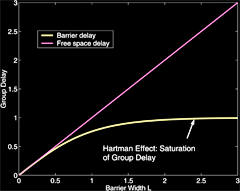
The Hartman Effect |
The Hartman effect is the tunneling effect through a barrier
where the tunneling time tends to a constant for large
barriers. This was first described by Thomas Hartman in
1962. This could, for instance, be the gap between two
prisms. When the prisms are in contact, the light passes
straight through, but when there is a gap, the light is
refracted. There is a finite probability that the photon will
tunnel across the gap rather than follow the refracted path. For
large gaps between the prisms the tunneling time approaches a
constant and thus the photons appear to have crossed with a
superluminal speed.
However, an analysis by Herbert Winful from the University of
Michigan suggests that the Hartman effect cannot actually be
used to violate relativity by transmitting signals faster than
c, because the tunneling time "should not be linked to a
velocity since evanescent waves do not propagate". Winful
means by this that the photons crossing the barrier are virtual
photons only existing in the interaction and could not be
propagated into the outside world.
Casimir effect
In physics, the Casimir effect or Casimir-Polder force is a
physical force exerted between separate objects due to resonance
of vacuum energy in the intervening space between the objects.
This is sometimes described in terms of virtual particles
interacting with the objects, due to the mathematical form of
one possible way of calculating the strength of the effect.
Because the strength of the force falls off rapidly with
distance, it is only measurable when the distance between the
objects is extremely small. Energy appears suddenly as if it
came from the vacuum. See Option B above for a discussion of
whether or not this effect could actually be used to send
signals faster than c or violate causality.
EPR Paradox
We can also quote the spectacular case of the thought experiment
of Einstein, Podolski and Rosen (EPR paradox) which could be
realized in experiments for the first time by Alain Aspect in
1981 and 1982 in the Aspect experiment. In this case, the
measurement of the state on one of the quantum systems of an
entangled pair forces the other system to be measured in the
complementary state. Thus functions quantum teleportation.
An experiment performed in 1997 by Nicolas Gisin at the
University of Geneva has demonstrated nonlocal quantum
correlations between particles separated by over 10
kilometers. But as noted earlier, the nonlocal correlations
seen in entanglement cannot actually be used to transmit
classical information faster than light, so that relativistic
causality is preserved; see no-communication theorem for further
information. A 2008 quantum physics experiment also performed by
Nicolas Gisin and his colleagues in Geneva, Switzerland has
determined that the "speed" of the quantum non-local connection
(what Einstein called spooky action at a distance) has a minimum
lower bound of 10,000 times the speed of light.
Delayed choice quantum eraser
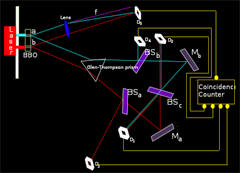
Delayed Choice Quantum Eraser |
Delayed choice quantum eraser (an experiment of Marlan Scully)
is a version of the EPR paradox in which the observation or not
of interference after the passage of a photon through a double
slit experiment depends on the conditions of observation of a
second photon entangled with the first. The characteristic of
this experiment is that the observation of the second photon can
take place at a later time than the observation of the first
photon, which may give the impression that the measurement
of the later photons "retroactively" determines whether the
earlier photons show interference or not, although the
interference pattern can only be seen by correlating the
measurements of both members of every pair and so it can't be
observed until both photons have been measured, ensuring that an
experimenter watching only the photons going through the slit
does not obtain information about the other photons in an FTL or
backwards-in-time manner.
Variable speed of light
In conventional physics, the speed of light in a vacuum is
assumed to be a constant. There exist theories which postulate
that the speed of light is not a constant. The interpretation of
this statement is as follows.
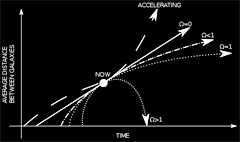
Variable Speed of Light |
The speed of light is a dimensional quantity and so, as has been
emphasized in this context by João Magueijo, it cannot be
measured. Measurable quantities in physics are, without
exception, dimensionless, although they are often constructed as
ratios of dimensional quantities. For example, when you measure
the height of a mountain you really measure the ratio of its
height to the length of a meterstick. The conventional SI system
of units is based on seven basic dimensional quantities, namely
distance, mass, time, electric current, thermodynamic
temperature, amount of substance, and luminous intensity.
These units are defined to be independent and so cannot be
described in terms of each other. As an alternative to using a
particular system of units, one can reduce all measurements to
dimensionless quantities expressed in terms of ratios between
the quantities being measured and various fundamental constants
such as Newton's constant, the speed of light and Planck's
constant; physicists can define at least 26 dimensionless
constants which can be expressed in terms of these sorts of
ratios and which are currently thought to be independent of one
another. By manipulating the basic dimensional constants one
can also construct the Planck time, Planck length and Planck
energy which make a good system of units for expressing
dimensional measurements, known as Planck units.
Magueijo's proposal used a different set of units, a choice
which he justifies with the claim that some equations will be
simpler in these new units. In the new units he fixes the fine
structure constant, a quantity which some people, using units in
which the speed of light is fixed, have claimed is time
dependent. Thus in the system of units in which the fine
structure constant is fixed, the observational claim is that the
speed of light is time-dependent.
While it may be mathematically possible to construct such a
system, it is not clear what additional explanatory power or
physical insight such a system would provide, assuming that it
does indeed accord with existing empirical data. |
|
|
